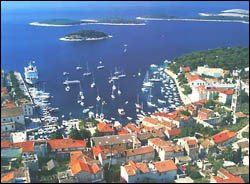Today, Hvar Town on the southwest coast of Hvar is probably Croatia's most fashionable resort. Old stone houses have been built into the sides of three hills which surround a bay. The highest peak is crowned by a Venetian fortress, dramatically floodlit by night.
Accommodation is available in hotels, apartments and pensions, while camping site are located in the vicinity. Tourism started to develop in the 1920s. Today, Hvar is one of the most frequently visited tourist centers in Dalmatia. The town has an extensive sports and recreational offer, as well as rich entertainment program, especially in the summer season that lasts longest in this part of Croatia. It is connected to the mainland by ferry lines to Split, Rijeka, Zadar and Dubrovnik. There are also ferry lines to other islands.
Besides the city of Hvar, there is a number of small villages offering accommodations mainly in apartments, Hvar city being a place to go out at night and sightseeing, while during day enyojing peceful natural surrounding. Apartment accommodation offers alternative to hotel accommodation not only with price, but also for possibility of interacting with locals. The private owners of Hvar apartments (apartmani Hvar on Croatian) will offer you a glass of "Prosek" delicious sweet wine, dry figs, tomatoes from their own garden, they will tell you how olives did this year etc. Everything differently from pro hotel atmosphere.
Saturday, May 05, 2007
Saturday, September 23, 2006
Croatian Hvar and other islands

Statistics will hardly tell you anything about the Hvar island villages and the isolated places enlivened by the local people and tourists who wish to get closer to nature. While separation from the mainland can sometimes be a handicap, it also provides some protection from the factory chimneys and other misfortunes which come with civilisation. Instead, there are vast fields of lavender, ancient olive trees and vineyards, in immaculate harmony between man and nature. There are wine and olives, so a guest wishing to get closer to nature will stop at a small inn rather than a top quality restaurant. He will taste real home-made wine instead of some famous sparkling wine, he will sing the old island songs and forget the monotony of the everyday routine. Through the centuries and life's sufferings, an oasis of culture has remained here, a testimony to the identity, despite the many attempts, some temporarily successful, to destroy it.
Every guest is really The Guest here and his every wish is a command. Hard-working hosts are well aware of this. They will offer home-made bread and smoked ham or freshly picked mandarins or fish garnished with home-pressed olive oil. Without additives or preservatives but with that natural taste that you sense when you feel a togetherness with unspoiled nature during your visit to the island.
Friday, September 08, 2006
Hvar - overview
As all good stories, this one also has to start with introduction ..
HVAR
Long warm days, old stone homes, vineyards and fields of lavender. Welcome to life on Hvar. Croatia’s little island in the Adriatic is safe, affordable and, well, intoxicating.
Floating just off Croatia’s drop-dead gorgeous Dalmatian coast, Hvar is far different from the other islands; think olive trees, fields of lavender, vineyards and rocky shores. But what Hvar shares with the other islands may surprise you; with an average of nearly eight hours of sunshine per day and water temperatures that hover around 70 degrees for at least half the year, it has one of Europe’s best climates.
Settled, over the centuries, by Venetians, Greeks and Croats, Hvar has a long history of art and culture. The 16th-century Spanjola fortress and the 17th-century municipal theater dominate Hvar town. Here, locals gather in cafés around the cobblestone square and along the palmshaded waterfront each evening to sip prosek, a dessert wine, and dine on local favorites like octopus salad or muckalica (pork cutlets). Beyond the town are rugged mountains scented with lavender and rosemary. You can also take a water taxi to the nearby Pakleni archipelago, where secluded strands of white sand, hiking trails and pine groves await.
HVAR
Long warm days, old stone homes, vineyards and fields of lavender. Welcome to life on Hvar. Croatia’s little island in the Adriatic is safe, affordable and, well, intoxicating.
Floating just off Croatia’s drop-dead gorgeous Dalmatian coast, Hvar is far different from the other islands; think olive trees, fields of lavender, vineyards and rocky shores. But what Hvar shares with the other islands may surprise you; with an average of nearly eight hours of sunshine per day and water temperatures that hover around 70 degrees for at least half the year, it has one of Europe’s best climates.
Settled, over the centuries, by Venetians, Greeks and Croats, Hvar has a long history of art and culture. The 16th-century Spanjola fortress and the 17th-century municipal theater dominate Hvar town. Here, locals gather in cafés around the cobblestone square and along the palmshaded waterfront each evening to sip prosek, a dessert wine, and dine on local favorites like octopus salad or muckalica (pork cutlets). Beyond the town are rugged mountains scented with lavender and rosemary. You can also take a water taxi to the nearby Pakleni archipelago, where secluded strands of white sand, hiking trails and pine groves await.
Friday, September 01, 2006
Subscribe to:
Comments (Atom)